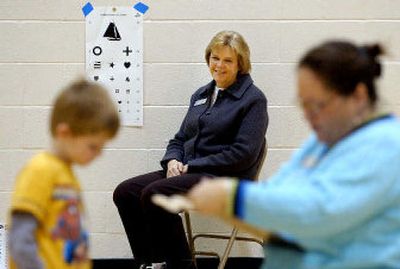School Nurse of the Year

For a few quarters, you can see one of Cindy Perry’s proudest achievements. You’ll find no chocolate bars, no soda pop, and no packages of frosted doughnuts in the Coeur d’Alene School District vending machines. Perry’s participation on the school Wellness Committee and her determination to have healthy food choices for students are some of the reasons she was selected as Idaho’s School Nurse of the Year.
She received the award in October at the state school nurse organization’s annual conference, which was held this year at Kootenai Medical Center. As co-president of the state group, Perry helped organize the event. Her nominators included nurses from her school district who praised her leadership skills, tactful manner and optimism.
Besides caring directly for students’ health, Perry supervises district nurses and certified nurses’ aides. When she took the job in 1997, she was hired as the sole nurse and was given an office in the central office basement. Her background was in obstetric and surgical nursing.
“I looked at the blank basement and said, ‘Oh my gosh, I wonder what it is that school nurses do,’ ” Perry said.
She started by asking the school principals what they thought her role would be. Before long, Perry had no trouble coming up with tasks. She rarely sits in the basement anymore. More likely, she’s shuttling among 16 schools while answering 50 or more phone calls per day.
Head lice need attention, a diabetic child requires insulin and an asthmatic forgot her inhaler. Fifth-grade “maturity classes” are scheduled, and a boy falls from a chair and needs a bag of ice.
As Perry walks through halls, kids want to show her a scratch or a sore toe. They really just want to talk, she believes. She’s often the first to hear if a girl thinks she’s pregnant and is the one teachers call to address a child with body odor or smelly feet. No topics are off-limits.
“Kids will tell you everything and that’s a huge responsibility,” she said.
It is often up to Perry to decide when parents or child protective services need to be notified. Reporting may mean losing a child’s trust and is the hardest part of the job, Perry said.
Less controversial are Perry’s duties in coordinating screenings for scoliosis, vision and dental care. Whooping cough suspects are referred to the Panhandle Health District. Playground injuries and asthma attacks are assessed for calls to 911.
Perry makes time for extra projects like participating in Action for Healthy Kids, a statewide initiative, that gave the school grant money to study topics such as how nutrition and exercise affect test scores. She was named to the Governor’s Council on Adolescent Pregnancy Prevention and travels with students spreading the message of Peers Encouraging Abstinent Kids.
As part of her healthier food mission, Perry helped test nutrient-rich snacks at students’ sports practices.
“Basically, we were trying to find out which foods they preferred,” she said. “They wouldn’t take plain raisins, even if they were starving.”
Fig bars made the cut, as well as nuts and pretzels. Pop Tarts are available, since they are a fortified cereal product. Perry offers them as proof that she is flexible and hasn’t removed everything that kids like to eat.
Opponents of the healthy changes feared that students would leave school grounds to get the snacks they wanted. Some were concerned with lost revenue. The school district’s director of food service, Linda Turner, said that none of these worries have come to pass.
Turner saw a small dip in sales of snack items in the beginning of the school year, but now they are back to baseline. Since the changes, she notices that kids are quieter at lunchtime and eat more fruits and vegetables.
Turner worked with Perry for several years on the wellness projects and felt she was a “perfect candidate” for the school nurse award.
“Nobody I can think of deserves that award more than she did,” Turner said. “She’s hardworking, and she really cares about kids.”
It was Perry who coaxed students into trying unfamiliar brands of snack foods. It was Perry who sent administrators every article she found on childhood obesity, inactivity or portion size.
“Cindy was always an advocate,” Turner said.
And it is Perry who sees the suffering of children firsthand. One child had high blood pressure and relied on fast foods. She talked with him about making better choices. He began exercising and improved enough to stop blood pressure medications.
Perry finds that most students are eager for her information.
“They want to be healthy,” she said. “They are very concerned when there’s something not right.”
Kootenai Medical Center has paid for Perry’s salary since her hiring. More nurses were added by the school district after seeing how much a nurse could do. Six nurses share the duties now and KMC granted additional funds last summer so Perry could extend her work into summer school. It felt like a break to her with 800 students instead of 10,000, but she believed the students needed her. Students with medical problems often show up in summer school to make up for lost time, she said.
Perry expresses gratitude for the support for school health services and holds out hope for more. She’d love to have a nurse for every school so that each child with medical concerns would be assured safe and necessary accommodations. She wishes for enough resources so no child “falls through the cracks.” She’d like every child to have good nutrition and physical activity. As kids head into college, she wants each one to be informed about the dangers of drugs and alcohol.
“What good is all this education and learning going to do if kids aren’t healthy?” she said.